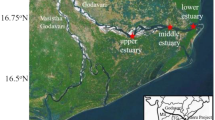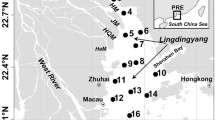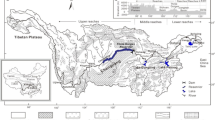Abstract
The development of river dams and further human activities (causing increased nitrogen (N) and phosphorus (P) nutrient loads), are responsible for a decline in dissolved silica concentrations (DSi) in many river systems. Here, the impact of the reduction of N- and P-concentrations on DSi is examined for the Rhine River. During the last decade of the twentieth century, annual average DSi concentrations increased by ~70% in the Rhine at Bimmen/Lobith, whereas nitrate (NO3) and phosphate (PO4) concentrations decreased by approximately one third. Accordingly, decadal changes in nutrient elemental ratios shifted the river system from DSi-limitation to P-limitation. Specifically, a seasonal DSi-concentration increase is observed from May to December for the Rhine River (with exception of June). Observed increases in DSi concentration are probably due to improvements in water-basin and land-use management, specifically a reduction in point-source P discharge, leading to P-limiting conditions for diatom growth. Data of the warm season suggest that as the system is moving through the transition from P-excess to P-limitation conditions, P-limitation according to the elemental ratio DSi/total phosphorus (TP) is occurring later than for the ratio DSi/PO4-P. Latter ratio will be buffered around ~16:1 during growing season. Reduction of N fertilization is less relevant, as N-limitation with respect to DSi is not achieved, even at the end of the analyzed period, but N-limitation may be reached in the future. Analysis of discharge–DSi relationship supports the hypothesis that DSi increase is affected by increasing P-limitation during the warm period and not only due to hydrological reasons. Results suggest, however, that the influence of hydrological parameters needs to be addressed in research for DSi concentration changes due to changed nutrient loads. Despite an overall increase in water temperature of 3°C over a 50-year period, no correlation with temperature was found for the last two decades of the twentieth century, for which DSi-data were available. In conclusion, in case of eutrophied river systems with excess of P, P-reduction may lead to an increase of DSi concentrations under certain conditions. This in turn is expected to impact not only DSi-sensitive coastal-zone ecosystems impacted by eutrophication but the carbon cycle as well.







Similar content being viewed by others
References
Admiraal W, Breugem P, Jacobs DMLH, Vansteveninck EDD (1990) Fixation of dissolved silicate and sedimentation of biogenic silicate in the Lower River Rhine during diatom blooms. Biogeochemistry 9(2):175–185
Admiraal W, Breebaart L, Tubbing DGMJ, van Zanten B, Ruijter De, van Steveninck ED, Bijkerk R (1994) Seasonal variation in composition and production of planktonic communities in the lower River Rhine. Freshw Biol 32:519–531
Beusen AHW, Bouwman AF, Dürr HH, Dekkers ALM, Hartmann J (2009) Global patterns of dissolved silica export to the coastal zone: Results from a spatially explicit global model. Glob Biogeochem Cycle 23. doi:10.1029/2008GB003281
Billen G, Garnier J (2007) River basin nutrient delivery to the coastal sea: assessing its potential to sustain new production of non-siliceous algae. Mar Chem 106(1-2):148–160
Billen G, Garnier J, Mouchel JM, Silvestre M (2007) The Seine system: introduction to a multidisciplinary approach of the functioning of a regional river system. Sci Total Environ 375(1–3):1–12
Bluth GJS, Kump LR (1994) Lithologic and climatologic controls of river chemistry. Geochim Cosmochim Acta 58(10):2341–2359
Buesseler KO, Lamborg CH, Boyd PW, Lam PJ, Trull TW, Bidigare RR, Bishop JKB, Casciotti KL, Dehairs F, Elskens M, Honda M, Karl DM, Siegel DA, Silver MW, Steinberg DK, Valdes J, Van Mooy B, Wilson S (2007) Revisiting carbon flux through the ocean’s twilight zone. Science 316(5824):567–570
Clasen J, Bernhardt H, Hoyer O, Wilhelms A (1982) Phosphate remobilization from the sediment and its influence on algal growth in a lake model. Arch Hydrobiol 18:101–113
Conley DJ, Smith WM, Cornwell JC, Fisher TR (1995) Transformation of particle-bound phosphorus at the land sea interface. Estuar Coast Shelf Sci 40(2):161–176
Conley DJ, Stalnacke P, Pitkanen H, Wilander A (2000) The transport and retention of dissolved silicate by rivers in Sweden and Finland. Limnol Oceanogr 45(8):1850–1853
Depetris PJ, Gaiero DM, Probst JL, Hartmann J, Kempe S (2005) Biogeochemical output and typology of rivers draining Patagonia’s Atlantic seaboard. J Coast Res 21(4):835–844. doi:10.2112/015-NIS.1
Dürr HH, Meybeck M, Hartmann J, Goulven GL, Roubeix V (2009) Global spatial distribution of natural river silica inputs to the coastal zone. Biogeosci Discuss 6:1345–1401
Friedl G, Teodoru C, Wehrli B (2004) Is the Iron Gate I reservoir on the Danube River a sink for dissolved silica? Biogeochemistry 68(1):21–32
Fulweiler RW, Nixon SW (2005) Terrestrial vegetation and the seasonal cycle of dissolved silica in a southern New England coastal river. Biogeochemistry 74(1):115–130
Garnier J, Billen G (2007) Production vs. respiration in river systems: an indicator of an “ecological status”. Sci Total Environ 375(1–3):110–124
Garnier J, Sferratore A, Meybeck M, Billen G, Dürr HH (2006) Modelling silica transfer processes in river catchments. In: Ittekkot V (ed) Role of silica in land–sea interactions. Island Press, Washington DC, pp 139–162
Garnier J, Billen G, Cebron A (2007) Modelling nitrogen transformations in the lower Seine River and estuary (France): impact of wastewater release on oxygenation and N2O emission. Hydrobiologia 588:291–302
Harashima A (2007) Evaluating the effects of change in input ratio of N:P:Si to coastal marine ecosystem. J Environ Sci Sust Soc 1:33–38
Harashima A, Kimoto T, Wakabayashi T, Toshiyasu T (2006) Verification of the silica deficiency hypothesis based on biogeochemical trends in the aquatic continuum of Lake Biwa-Yodo River-Seto Inland Sea, Japan. Ambio 35(1):36–42
Hartmann J, Levy JK, Okada N (2006) Managing surface water contamination in Nagoya, Japan: an integrated water basin management decision framework. Water Res Manag 20(3):411–430. doi:10.1007/s11269-006-0323-6
Hartmann J, Jansen N, Kempe S, Dürr HH (2007) Geochemistry of the river Rhine and the upper Danube: Recent trends and lithological influence on baselines. J Environ Sci Sust Soc 1:39–46. doi:10.3107/jesss.1.39
Hartmann J, Kunimatsu T, Levy JK (2008) The impact of Eurasian dust storms and anthropogenic emissions on atmospheric nutrient deposition rates in forested Japanese catchments and adjacent regional seas. Glob Planet Change 61(3–4):117–134. doi:10.1016/j.gloplacha.2007.08.001
Hartmann J, Jansen N, Dürr HH, Harashima A, Okubo K, Kempe S (2010) Predicting riverine dissolved silica fluxes into coastal zones from a hyperactive region and analysis of their first order controls. Int J Earth Sci 99:207–230. doi:10.1007/s00531-008-0381-5
Humborg C, Blomqvist S, Avsan E, Bergensund Y, Smedberg E, Brink J, Morth CM (2002) Hydrological alterations with river damming in northern Sweden: implications for weathering and river biogeochemistry. Glob Biogeochem Cycle 16(3):1039. doi:10.1029/2000GB001369
Humborg C, Smedberg E, Blomqvist S, Morth CM, Brink J, Rahm L, Danielsson A, Sahlberg J (2004) Nutrient variations in boreal and subarctic Swedish rivers: landscape control of land–sea fluxes. Limnol Oceanogr 49(5):1871–1883
Humborg C, Pastuszak M, Aigars J, Siegmund H, Morth CM, Ittekkot V (2006) Decreased silica land–sea fluxes through damming in the Baltic Sea catchment—significance of particle trapping and hydrological alterations. Biogeochemistry 77(2):265–281
Ietswaart T, Breebaart L, van Zanten B, Bijkerk R (1999) Plankton dynamics in the river Rhine during downstream transport as influenced by biotic interactions and hydrological conditions. Hydrobiologia 410:1–10
Jansen N, Hartmann J, Lauerwald R, Dürr HH, Kempe S, Loos S, Middelkoop H (2010) Dissolved silica mobilization in the conterminous USA. Chem Geol 270(1–4):90–109. doi:10.1016/j.chemgeo.2009.11.008
Kempe S, Krahe P (2005) Water and biogeochemical fluxes in the river Rhine catchment. Erdkunde 59:216–250
Kristiansen S, Hoell EE (2002) The importance of silicon for marine production. Hydrobiologia 484(1–3):21–31
Libiseller C, Grimvall A (2002) Performance of partial Mann–Kendall tests for trend detection in the presence of covariates. Environmetrics 13(1):71–84
Meybeck M (2003) Global analysis of river systems: from Earth system controls to Anthropocene syndromes. Philos Trans R Soc B Biol Sci 358(1440):1935–1955
Meybeck M (2004) The global change of continental aquatic systems: dominant impacts of human activities. Water Sci Technol 49(7):73–83
Mostert E (2003) The European Water Framework Directive and water management research. Phys Chem Earth 28(12-13):523–527
Radach G, Patsch J (2007) Variability of continental riverine freshwater and nutrient inputs into the North Sea for the years 1977–2000 and its consequences for the assessment of eutrophication. Estuaries Coasts 30(1):66–81
Rahm L, Conley D, Sanden P, Wulff F, Stalnacke P (1996) Time series analysis of nutrient inputs to the Baltic sea and changing DSi:DIN ratios. Mar Ecol Prog Ser 130(1–3):221–228
Schol A, Kirchesch V, Bergfeld T, Scholl F, Borcherding J, Muller D (2002) Modelling the chlorophyll a content of the River Rhine—interrelation between riverine algal production and population biomass of grazers, rotifers and the zebra mussel, Dreissena polymorpha. Int Rev Hydrobiol 87(2–3):295–317
Seitzinger SP, Kroeze C, Bouwman AF, Caraco N, Dentener F, Styles RV (2002) Global patterns of dissolved inorganic and particulate nitrogen inputs to coastal systems: recent conditions and future projections. Estuaries 25(4B):640–655
Seitzinger SP, Harrison JA, Dumont E, Beusen AHW, Bouwman AF (2005) Sources and delivery of carbon, nitrogen, and phosphorus to the coastal zone: an overview of Global Nutrient Export from Watersheds (NEWS) models and their application. Glob Biogeochem Cycle 19(4):GB4S01
Semhi K, Suchet PA, Clauer N, Probst JL (2000a) Dissolved silica in the Garonne River waters: changes in the weathering dynamics. Environ Geol 40(1-2):19–26
Semhi K, Suchet PA, Clauer N, Probst JL (2000b) Impact of nitrogen fertilizers on the natural weathering–erosion processes and fluvial transport in the Garonne basin. Appl Geochem 15(6):865–878
Sferratore A, Billen G, Garnier J, Thery S (2005) Modeling nutrient (N, P, Si) budget in the Seine watershed: application of the Riverstrahler model using data from local to global scale resolution. Glob Biogeochem Cycle 19(4):GB4S07
Staffel-Schierhoff U (2001) Schadtstoffgruppenorientierte Aktionskonzepte am Beispiel der Nährstoffreduzierung. In: Rudolph KU, Block T (eds) Der Wassersektor in Deutschland - Methoden und Erfahrungen, Bundesministeriums für Umwelt. Naturschutz und Reaktorsicherheit und des Umweltbundesamtes, Berlin, pp 91–100
Stalnacke P, Grimvall A, Libiseller C, Laznik A, Kokorite I (2003) Trends in nutrient concentrations in Latvian rivers and the response to the dramatic change in agriculture. J Hydrol 283(1–4):184–205
Turner RE (2002) Element ratios and aquatic food webs. Estuaries 25(4B):694–703
Turner RE, Rabalais NN, Justic D, Dortch Q (2003) Global patterns of dissolved N, P and Si in large rivers. Biogeochemistry 64(3):297–317
Van Dokkum HP, Hulskotte JHJ, Kramer KJM, Wilmot J (2004) Emission, fate and effects of soluble silicates (waterglass) in the aquatic environment. Environ Sci Technol 38(2):515–521
Vansteveninck EDD, Admiraal W, Breebaart L, Tubbing GMJ, Vanzanten B (1992) Plankton in the River Rhine—structural and functional-changes observed during downstream transport. J Plankton Res 14(10):1351–1368
Weitere M, Scherwass A, Sieben KT, Arndt H (2005) Planktonic food web structure and potential carbon flow in the lower river Rhine with a focus on the role of protozoans. River Res Appl 21(5):535–549
Acknowledgments
BFG (Federal Institute of Hydrology, Koblenz) supplied the data. Specifically, Frank Walter is thanked for answering many questions on data quality and monitoring programs. Claudia von Brömssen (former Libiseller) provided the trend analysis software and was helpful throughout the project. Two anonymous reviewers and Dan Conley helped to improve a previous version of this manuscript. This study was supported through the German Science Foundation (DFG), project number HA 4472/6-1, and through the Cluster of Excellence ‘CliSAP’ (EXC177), Universität Hamburg, funded through the German Science Foundation (DFG).
Author information
Authors and Affiliations
Corresponding author
Rights and permissions
About this article
Cite this article
Hartmann, J., Levy, J. & Kempe, S. Increasing dissolved silica trends in the Rhine River: an effect of recovery from high P loads?. Limnology 12, 63–73 (2011). https://doi.org/10.1007/s10201-010-0322-4
Received:
Accepted:
Published:
Issue Date:
DOI: https://doi.org/10.1007/s10201-010-0322-4




